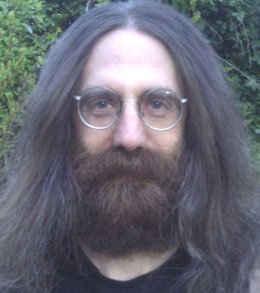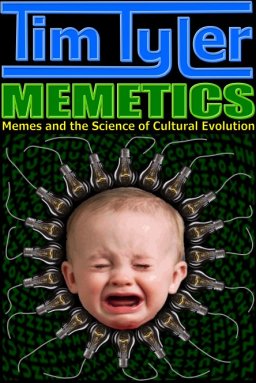Transcript:
Hi. I'm Tim Tyler, and this is a review of this book:
The Mocking Memes:A Basis for Automated Intelligence by Evan Louis Sheehan
This is a great book. In fact I think the author's views of the topic of memetics are more similar to my own views that practically any other author I can think of. Like me, the author cites the work of A.G. Cairns-Smith on genetic takeovers, and discusses the possibility of a memetic takeover. Also like me, the author is interested in the link between memetics and machine intelligence.
The author doesn't seem particularly interested in orthodox views. He starts out by radically redefining the term "meme" to be the inherited unit in universal Darwinism. That's a radical break with tradition, and I can't say I entirely approve - though certainly the inherited unit in universal Darwinism is badly in need of a name. He also radically redefines the term "information" - to means something other than what the term means in Shannon's information theory. This seems to be getting more into crank territory, and I don't think the author pulls this one off. Like me, the author regards evolution as purposeful. Like me, the author sees deep links to moral behaviour in evolutionary theory. Both views are contrary to mainstream orthodoxy.
I love this book, and don't want to spend too much time criticizing it. However, if I have to say some bad things: the book doesn't refer to the scientific literature enough for my tastes. The literature on universal Darwinism is fairly patchy, but there's more to it that this book might suggest. I also felt that the universal Darwinism was of a rather mild kind, that only covered the biological realm. An extreme form of universal Darwinism that extends to propagating cracks, turbulence, flames and crystals seems quite defensible, but such ideas don't get coverage in this book.
Probably my favourite part of the book was where an argument for Lamarckism in the organic realm was presented.
Lamarckism - in the form of the inheritance of acquired characteristics - is an idea which is widely disparaged in modern times. One of the common arguments given against cultural evolution being Darwinian is that it works partly on Lamarckian principles, while organic evolution is solely Darwinian. A common response is that cultural evolution is not Lamarckian either - however here I will take a different position.
Lamarck apparently thought that all acquired traits could potentially be inherited. However the fact that some acquired characteristics are inherited in the organic realm is pretty obvious - such as when a dog acquires fleas and then its offspring inherit them. Indeed, with 8% of human DNA inherited from viruses, it seems difficult to argue that no acquired traits are inherited. At this point, there are various replies by those who still want to claim that organic inheritance is wholly non-Lamarckian - I won't go into those here. This book provides another type of case where we see the inheritance of acquired characteristics in the organic realm - one that doesn't involve symbiosis. The author argues that surgical breast enhancements are inherited, and tend to produce offspring with larger breasts. A mechanism is provided: those with breast enhancements tend to attract mates who prefer larger breasts, and some of that preference will have a genetic basis. Genes in men for a preference for larger breasts will tend to be statistically linked to genes whose expression produces bigger breasts when in women, due to their shared evolutionary history. So: we can expect breast enhancement patients to have offspring with larger breasts than would have been produced if no enhancement surgery had taken place. The reasoning here can be applied to most sexually-selected traits. It also works with traits that can be amplified naturally - using Lamarck's principle of use and disuse - such as large, bulging muscles.
The centerpiece of the book is a large section about the memory-prediction framework and bi-directional hierarchies in the brain. This material was inspired by Jeff Hawkins' book On Intelligence. While interesting, this was the most long-winded and difficult section of the book. While I am sympathetic to the idea of the brain as a prediction engine, I think machine intelligence will feature a considerable quantity of bottom-up engineering, with neuroscience and biomimicry playing a relatively minor role. The author seems to envisage a much more neuroscience-inspired approach than I do. An aeroplane and a bird both make use of lift. Similarly, a computer and a brain will both be masters of inductive inference. However, they differ considerably in the details of their operation. The brain is hampered considerably by design constraints - like being made mostly out of cells - and having to squeeze through the female human pelvis. We should be able to do much better.
The book finishes by discussing the evolving universes of Smolin and Gardner, and proposing an alternative hypothesis - involving worlds simulating worlds which in turn are simulating worlds. Though labelled as speculation, such a scenario seems relatively unlikely to me.
Anyway, this is a great book. As well as hard copy, it's also available as a free download on the author's web site.
Enjoy.
 In The Laughing Genes - A Scientific Perspective on Ethics and Morality Evan Louis Sheehan has a great analogy for meme-gene coevolution. He says:
In The Laughing Genes - A Scientific Perspective on Ethics and Morality Evan Louis Sheehan has a great analogy for meme-gene coevolution. He says: In
In  One way of modelling human culture is as an extension of human biology. If you do that then one way of modelling cultural information is as part of a human extended genotype. The products of culture would then be modelled as being part of the phenotype of that extended genotype. This type of model is, alas, common in academic studies of cultural evolution. As Mesoudi (2011) puts it:
One way of modelling human culture is as an extension of human biology. If you do that then one way of modelling cultural information is as part of a human extended genotype. The products of culture would then be modelled as being part of the phenotype of that extended genotype. This type of model is, alas, common in academic studies of cultural evolution. As Mesoudi (2011) puts it:









